Hellblade: Senua’s Sacrifice is both great and terrifying, taking the player on a journey into madness.
In the game from British game studio Ninja Theory, the Celtic warrior Senua struggled with inner demons locked in a battle over her mind, and she carries a sword that makes her a lethal danger. She is on a quest to save her beloved Dillion, who has been slain by Northmen. Senua must go to the Norse version of hell to not just retrieve Dillion from the dead but also deal with the legacy of her ill-fated parents. It is an insane quest in a nightmare world, undertaken by a hero who is so emotionally disturbed that you wonder if all of it takes place in her head.
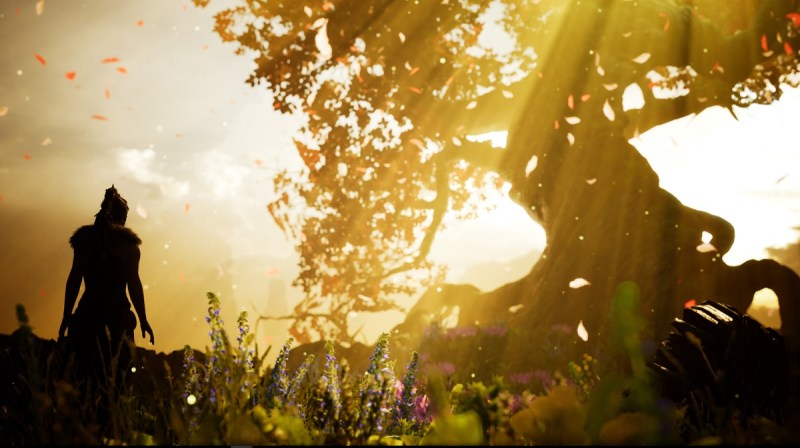
Above: Dream or nightmare in Hellblade.
This is perhaps the scariest game I’ve ever played, and not just because it goes over the top with the violence, gore, and burning bodies. Given its subject matter about insanity, you could say that the graphics are understated. It is not about pure horror. Rather, it is a fantasy sword-fighting game that tries to capture what it’s like to be afflicted in a world where you see things that no one else can see. The subject matter is disturbing, and I wouldn’t recommend it for all audiences.
But it is an important game, debuting today for PC and PlayStation 4.
As the player, you see the world through Senua’s eyes, and you feel an enormous sense of empathy for her struggle. Ninja Theory has worked closely with psychiatrist and professor of health neuroscience, Paul Fletcher, from the University of Cambridge, to accurately portray Senua’s mental illness. The project received support from Wellcome Trust, a global charitable foundation that focuses on health.
The sword battles are awesome. But the ultimate lesson comes from Dillion: “The hardest battles are fought in the mind, not with the sword.”
Check out our Reviews Vault for past game reviews.
What you’ll like
A strong female character with an ordinary look

Above: Senua is an ordinary character, except for the blue tattoo.
Senua’s actor is Melina Juergens. She was Ninja Theory’s video editor, and she was a stand-in at first. But she did such a good job that the developers cast her. The video game character doesn’t have a super-endowed physique, like many video game characters of the past, and that’s good. She looks like an everyday woman. This makes the game more realistic. It makes a strong statement that video game characters don’t have to be superheroes. They can be ordinary people who are put into impossible situations and deal with it as best they can.
Senua is vulnerable and emotionally distraught for much of the story. She screams (with good reason) often. But she finds strength through her quest, and this rage transforms her into a badass opponent that demons and gods fear. Outstanding movie-like cutscenes and dramatic pacing tells a story that, in scene after scene, starts out slow and then reaches a nightmare crescendo. With the lead being a woman, it brings out more emotion in the protagonist — and it turns the old rescue tropes on their heads.
A deep exploration of mental illness
Senua makes a journey into hell, searching for her loved one. She battles demons, real and imagined. She hears voices in her head. Sometimes they are useful, like when they tell her to watch out behind her during a sword fight with multiple opponents. But much of the time, they are there to place doubts in Senua’s mind, eating away at her purpose. She must push them aside and continue on her quest to bring back the dead.
This journey is a metaphor for a real descent into madness, and I spent much of the time worried about how it would turn out. Would we discover that it was all in her head, and that she was ill? Or that she was the only sane person in a world driven mad by petty gods and all-to-real monsters? Should Senua give in to the inner demons or continue on her quest? And maybe you, as the player, are the insane one?
The depiction of madness comes into the gameplay. One of the most interesting puzzle mechanics is when you try to line up something in your vision, so that you can see through the illusion and discover a hidden path. This is one of Senua’s gifts. She sees things that no one else perceives. That’s a definition of madness, but it’s also the definition of genius. The gameplay gives you a chance to see that thin line.
Outstanding facial animation
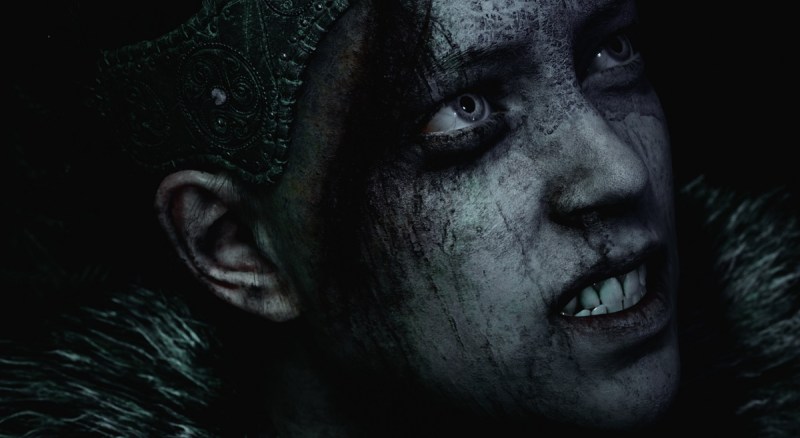
Above: That’s Senua under all that blood and grime.
Ninja Theory does an outstanding job of realistically rendering an animated human face — better than I’ve seen in any other game. The studios used the Unreal Engine, 3 Lateral, and Cubic Motion technology to capture Juergens’ acting performances and render them as an animated game character. The nuances of facial movement are exact. Senua’s eyes are expressive, watering up in emotional moments and expressing fright during moments of terror. Over time, Senua collects dirt, scars, and bloodstains on her face, but underneath, you can see it is still her. I think we’re over the uncanny valley, or the notion that the more realistic an animation of a human face becomes, the more eerie and wrong it feels.
Reminders of the past
The story reminds me of Michael Moorcock’s classic fantasy novels, like Elric of Melnibone. Elric has a sword that turns him into a demon slayer, but the champion is also cursed. In contrast to Moorcock’s Eternal Champion series, Senua’s Sacrifice features a female hero. It flips those books around; Senua also finds a legendary sword that can slay gods, but it brings her much pain as well.
It also takes me back to works of art like Dante’s Inferno, the myth of Orpheus and Eurydice, and What Dreams May Come. These tales of a descent into hell are disturbing, but none so much as this one because of the depiction of madness.
Difficult sword fights
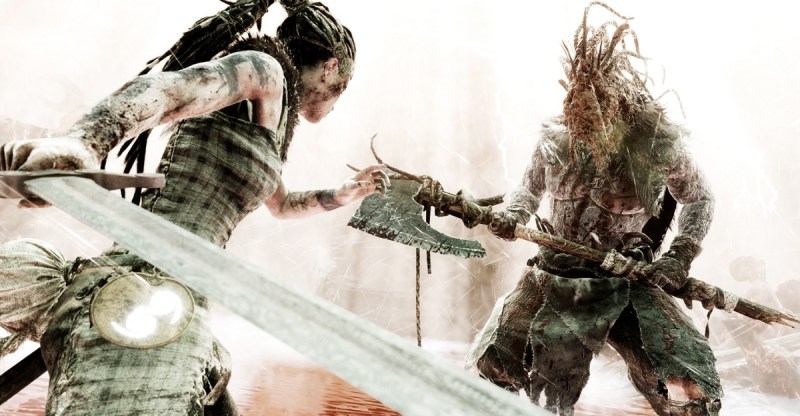
Above: Axe or sword?
The sword-fighting is relentless. Like in Ubisoft’s For Honor, you must get the timing just right. You can thrust, do a quick slash, or aim a heavy blow. But you aren’t all-powerful, and even one of the weaker villains can bring you down if you get your timing wrong. When you have the advantage, you must press it. And when you are fighting an all-powerful enemy, you have to use your accumulated “focus,” which enables you to slow down time and get in a bunch of blows all at once. But that doesn’t make it easy. You can’t even hit some of the demons until you use your focus, and then you have to wait for it to build up again before you can strike. I fought many battles over and over. It felt like I was in a duel in Game of Thrones.
Variations in gameplay
This would be a boring game if all it had was swordfights. After all, Senua doesn’t even have a shield or a bow. But she also spends a lot of time escaping from nightmares. Sometimes, this means creeping in total darkness past some beasts who are breathing heavily. Sometimes it means she must spot symbols in the landscape while fleeing a fire. As mentioned, you have to spend a lot of your time solving puzzles by looking at the same scenes from different points of view. I thought these variations in gameplay, just like the story itself, were wonderfully creative.
What you won’t like
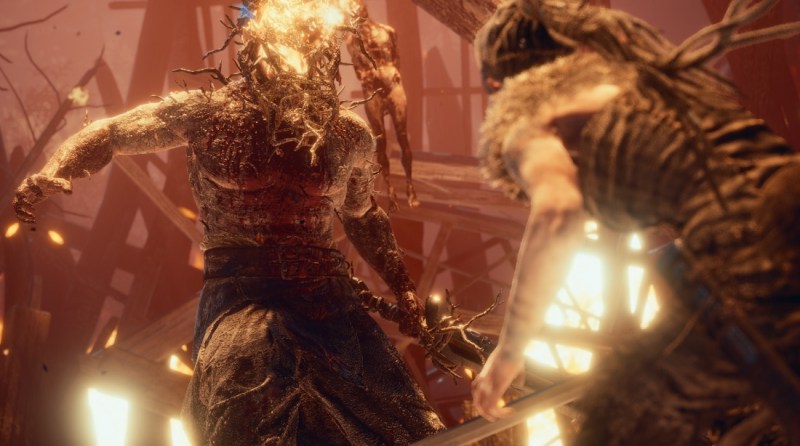
Above: I defeated this sort of character maybe 50 times in Hellblade.
Occasional clipping
One in a while, when you are climbing circular stairs, the graphics do a hiccup and you start walking through the wall. This also happens during fight scenes, and it means that for a moment, it blocks your view. You have to move in order to get back to normal graphics, but in hand-to-hand combat, this can often mean that you’re a split-second too slow, and you’ll die.
Repetition
While the sword battles are challenging, they are also repetitive. If you die in a melee in which you must take out 10 enemies, you’ll have to start all over again. This means you have to develop your sword-fighting skill over the game’s course. But it also means that you’ll see the same half-dozen enemies over and over again. If you don’t enjoy the basic swordplay as much as I did, then this could drive you nuts.
Faceless villains
You battle many evil warriors, but they don’t really have faces. We know that Ninja Theory is capable of creating outstanding human faces. But it chose to depict the villains wearing masks. Some of these villains, like Senua’s father, have devilish voices that can freak you out. Perhaps this is a good thing, as the only fleshed-out character is Senua herself. But I wished that Ninja Theory had invested in creating a more memorable villain to counter Senua’s heroism.
Conclusion
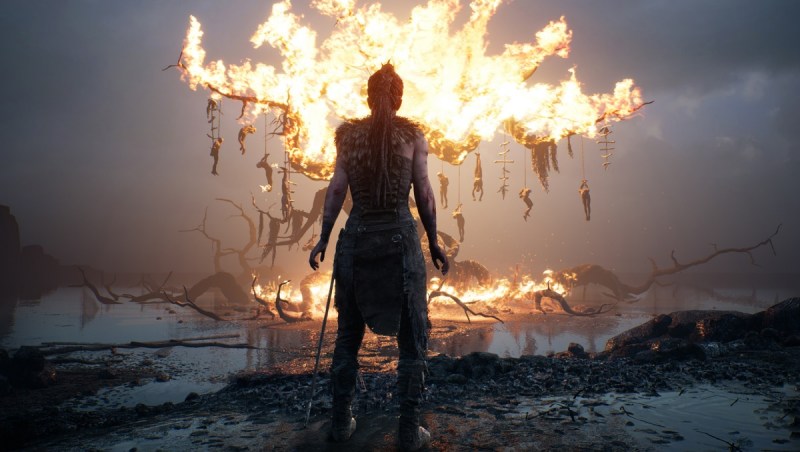
Above: Real or madness? It’s all-too-real for Senua.
You could say that the weak villains, repetitive play, lack of multiplayer, and clipping bugs could doom a game like Hellblade. But I’ll happily overlook those because of the great character, compelling acting, awesome cinematics, beautiful environments, variety of gameplay, and its deep exploration of madness. It is a difficult game to beat, and it is hard to experience.
The ending of the game will leave you wondering just what was real and what was an illusion. I thoroughly enjoyed the dramatic arc of each major scene. It starts out calm, moves to disturbing, and then descends into chaos and madness. I think the storytellers and designers exercised tight creative control, with a game that is understated as well as explosive.
It might have been madness for a small studio like Ninja Theory to take on such a herculean task of self-publishing this game, but I’m glad they made the effort.
Score: 95/100
Hellblade: Senua’s Sacrifice comes out for PC and PlayStation 4 on August 8. Ninja Theory sent us a PS4 code for the purposes of this review.

